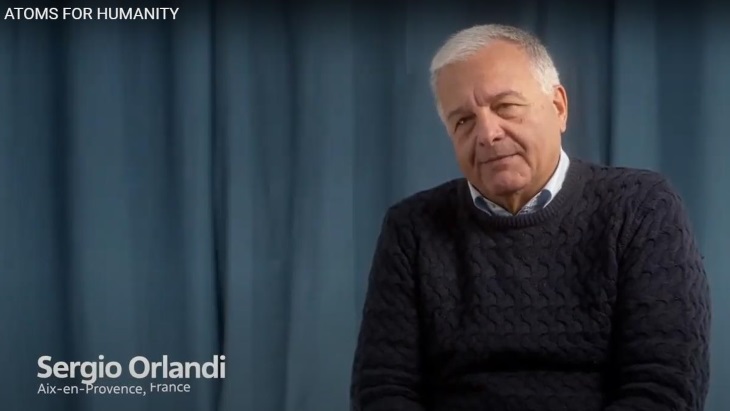Orlandi was speaking at the Why Humanity Needs Nuclear webinar, which was held last week for the launch of Rosatom's Atoms for Humanity initiative. The discussion centred on the social, environmental and global partnerships aspects of the United Nations Sustainable Development Goals. It was moderated by Kirsty Gogan, managing partner at Lucid Catalyst and a co-founder of Terra Praxis.
ITER is a major international project to build a tokamak fusion device designed to prove the feasibility of fusion as a large-scale and carbon-free source of energy. The European Union is contributing almost half of the cost of its construction, while the other six members (China, India, Japan, South Korea, Russia and the USA) are contributing equally to the rest.
The goal of ITER, which is in Cadarache, France, is to operate at 500 MW (for at least 400 seconds continuously) with 50 MW of plasma heating power input. It appears that an additional 300 MWe of electricity input may be required in operation. No electricity will be generated at ITER. First plasma is planned for 2025, with deuterium-tritium fusion experiments commencing in 2035.
Human endeavour
Atoms for Humanity highlighted the ITER project for its discussion about global partnerships. Gosgen described it as not merely an ambitious engineering project, but as "a collective human endeavour involving the participation of two-thirds of the world's countries".
Orlandi said the project is an integrated international project involving seven stakeholders, which requires the unification of efforts to create a global integrated design. A central workforce of 1000 in Cadarache is managing that integration process for the various designs coming from different parts of the world, he said. This follows both international regulations and French rules and standards, which have to be "implemented and customised in one delivery", he added.
"This is something very delicate, very challenging, but I really believe this gives us the capacity to move this train because the motivation is very high. We know very well that we are on the border of the new technology, of scientific development, but we also know that we are making something which is historical and good for humanity. Our target is to be able to produce energy at low cost for all the human population whilst respecting and satisfying all the environmental requirements," he said.
Gogan said that, beyond the unprecedented level of cooperation involved for the project, its sheer scale was itself remarkable.
"ITER will be capable of producing 500 megawatts of thermal power, ensuring an amplification ratio [of the fusion reaction] of Q ≥ 10 based on the consumption of 50 megawatts," Orlandi said. "So we want to demonstrate with this ITER fusion nuclear power plant that we are capable of producing more energy than we absorb and this 'how much' has to be equal to 10."
The ITER experiments will take place inside the vacuum vessel, a hermetically sealed steel container that houses the fusion reactions and acts as a first safety containment barrier. In its doughnut-shaped chamber, or torus, the plasma particles spiral around continuously without touching the walls. In a tokamak device, such as ITER, the larger the vacuum chamber volume, the easier it is to confine the plasma and achieve the type of high energy regime that will produce significant fusion power.
To achieve "the star reaction", a temperature of 150 million degrees Centigrade has to be achieved inside the toroidal plasma chamber, Orlandi said.
"No temperature like that can be supported by any material. It is for this reason that we are really on the border of scientific knowledge and technology," he said. ITER's integration of new technologies in superconductivity, cryogenics, vacuums, electrical power transportation and mechanics is a feat that "up to a few years ago was really mission impossible and difficult to be imagined", he added.
Beyond engineering
When asked about the mission of ITER beyond the engineering aspects of the project, Orlandi highlighted the importance of the fuel.
Although different isotopes of light elements can be paired to achieve fusion, the deuterium-tritium reaction has been identified as the most efficient for fusion devices. ITER and future devices will use these two hydrogen isotopes to fuel the fusion reaction. Deuterium can be distilled from all forms of water. In every cubic metre of seawater, for example, there are 33 grams of deuterium.
"This is what makes this plant, once we have tested its production, something that is valid for all humanity at really low cost because we won’t have anymore the really big impact on cost of the fuel," Orlandi said.
In a film to accompany the interview, Orlandi said that his fascination with the nucleus began in childhood. At ITER, which he joined in 2013 at the age of 57, he is leading "the dream to simulate the sun on Earth".
"Today I am 64 but I feel so young," he said. "It isn't important how old you are; it's how young you are in approaching the target that you have in front of you."
With 25 nations working together "as one unit team", he said, ITER "represents the future of all countries".
"It's a way to produce energy at low cost from a nuclear source that is an endless," he said, which means everyone, everywhere will be able to have an equally high standard of living and level of wellbeing.
"When I met my wife, in 1977, we talked a lot about helping other people because giving without expecting anything back is the best way towards achieving something impressive for yourself," he said. "Energy is needed by all countries all over the world and this is something very important for all of us to achieve."
A recording of Why Humanity Needs Nuclear is here.






_18570.jpg)
_16159.jpg)
_49205.jpg)





